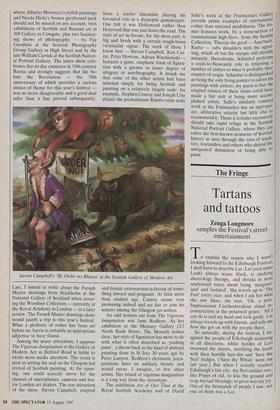Exhibitions
The Vigorous Imagination (Scottish Gallery of Modern Art, till 25 October) June Redfern (Mercury Gallery, till 5 September) Art of Our Time
(Royal Scottish Academy, till 31 August)
David Salle (Fruitmarket Gallery, till 20 September) The Queen's Image (Scottish National Portrait Gallery, till 4 October)
Barrie's the word
Giles Auty
My education in matters Scottish con- tinues apace. Already, with the aid of Edinburgh artists, I have learned tw°, useful words of regional patois: tarrie 'Rocket: 1-6', by Nicola Hicks (fine, brilliant) and 'teuchter' (a rough Highlander or other Scot from the north). So far as I know the two words are seldom seen in written form and, in Edinburgh at least, are rarely used together. By means of this rapid progress I hope to have mastered local dialect by the turn of the century, although I understand that spoken Glaswegian may take me a few years longer.
This year's festival art exhibitions, with a couple of possible exceptions, are brilliant indeed and extremely numerous. Much of this week's review could have been made up simply in the form of gallery listings but this option might seem like scrimshanking, an underhand way of earning a reviewer's wages. Among others, the Calton Gallery (10 Royal Terrace) deserves honourable mention for a very funny invitation card and for showing some worthy British and European paintings. I would also like to have reviewed at length superb exhibitions at the Scottish Gallery in George Street. where Alberto Morrocco's stylish paintings and Nicola Hicks's bronze greyhound pack should not be missed on any account; twin exhibitions of Scottish and Russian art at 369 Gallery in Cowgatc, plus two fascinat- ing shows of photography — by Fay Goodwin at the Scottish Photography Group Gallery in High Street and by the late William Carrick at the Scottish Nation- al Portrait Gallery. The latter show cele- brates day-to-day existence in 19th-century Russia and strongly suggests that life be- fore the Revolution — the 70th anniversary of which provides a curious choice of theme for this year's festival was no more disagreeable and a good deal safer than it has proved subsequently. from a scarlet limousine playing his favoured role as a dyspeptic gamekeeper. One felt it was Hollywood rather than Holyrood that was just down the road. The style of art in favour, for the most part, is big and brash with a certain rough-hewn vernacular vigour. The work of those I know best — Steven Campbell, Ken Cur- rie, Peter Howson, Adrian Wiszniewski features a giant, emphatic form of figura- tion with a greater or lesser degree of allegory or autobiography. It struck me that some of the other artists had been selected simply for being Scottish and painting on a relatively largely scale: for example, Stephen Conroy and Joseph Urie abjure the predominant Rambo-style male Steven Campbell's 'By Order no Rhinos' at the Scottish Gallery of Modern Art.
Last, I intend to write about the French Master drawings from Stockholm at the National Gallery of Scotland when cover- ing the Woodner Collection — currently at the Royal Academy in London — in a later review. The French Master drawings alone would justify a trip to this year's festival. What a plethora of riches has been set before us; barrie is certainly an appropriate adjective to have found.
Among the many attractions, I suppose The Vigorous Imagination at the Gallery of Modern Art in Belford Road is liable to excite most media attention. The event is seen as setting the seal on the Glasgow-led revival of Scottish painting. At the open- ing, one could scarcely move for the clusters of microphones, cameras and ma- jor London art dealers. The star attraction of the show, Steven Campbell, erupted and female extroversion in favour of some- thing inward and poignant. At little more than student age, Conroy seems very promising indeed and set fair to join his seniors among the Glasgow jet-setters.
An odd woman out from The Vigorous Imagination was June Redfern. As her exhibition at the Mercury Gallery (2/3 North Bank Street, The Mound) makes clear, her style of figuration has more to do with what is often described as 'pushing paint', a throw-back to the kind of abstract painting done in St Ives 30 years ago by Peter Lanyon. Redfern's chromatic juxta- positions have an unlikely beauty and would occur, I imagine, to few other artists. Her brand of vigorous imagination is a long way from the stereotype.
The exhibition Art of Our Time at the Royal Scottish Academy and of David
Salle's work at the Fruitmarket Gallery provide prime examples of international rather than national modishness. The for- mer features work, by a cross-section of transnational high-fliers, from the Saatchi Collection. Therein the good — Auerbach, Kiefer — rubs shoulders with the appal- ling, which all but the myopic will identify instantly. Hereabouts, Schnabel performs a coals-to-Newcastle role in returning a number of antlers to what is probably their country of origin. Schnabel is distinguished as being the only living painter to adorn his paintings with antlers; my guess is that the original owners of these items could have made a fair stab at being more accom- plished artists. Salle's similarly vaunted work at the Fruitmarket has an appropri- ate, alliterative salacity but little else to recommend it. Those it irritates excessively should take rapid refuge in the Scottish National Portrait Gallery, where they can relive the best-known moments of Scottish history as seen through the eyes of tench- ters, lowlanders and others who shared the antiquated distinction of being able to
paint.



















































 Previous page
Previous page